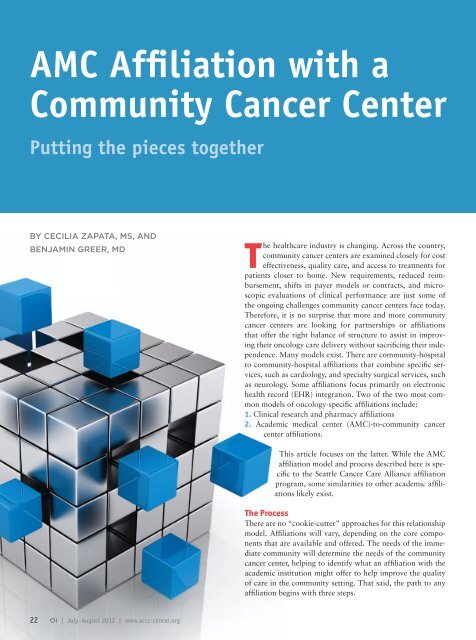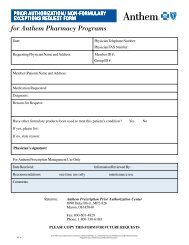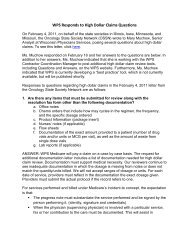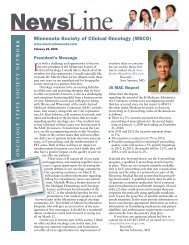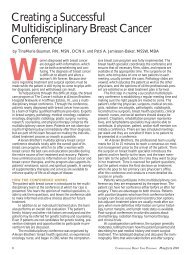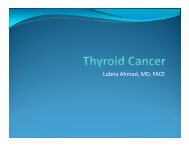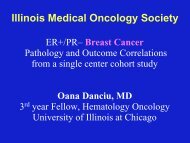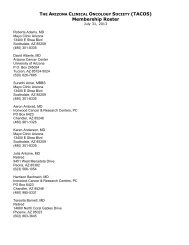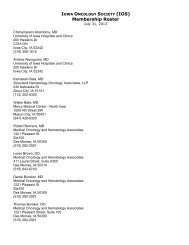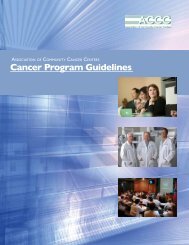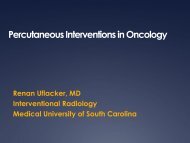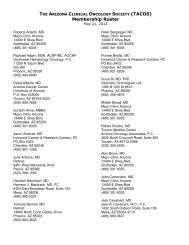AMC Affiliation with a Community Cancer Center - Association of ...
AMC Affiliation with a Community Cancer Center - Association of ...
AMC Affiliation with a Community Cancer Center - Association of ...
Create successful ePaper yourself
Turn your PDF publications into a flip-book with our unique Google optimized e-Paper software.
<strong>AMC</strong> <strong>Affiliation</strong> <strong>with</strong> a<br />
<strong>Community</strong> <strong>Cancer</strong> <strong>Center</strong><br />
Putting the pieces together<br />
BY CECILIA ZAPATA, MS, AND<br />
BENJAMIN GREER, MD<br />
The healthcare industry is changing. Across the country,<br />
community cancer centers are examined closely for cost<br />
effectiveness, quality care, and access to treatments for<br />
patients closer to home. New requirements, reduced reimbursement,<br />
shifts in payer models or contracts, and microscopic<br />
evaluations <strong>of</strong> clinical performance are just some <strong>of</strong><br />
the ongoing challenges community cancer centers face today.<br />
Therefore, it is no surprise that more and more community<br />
cancer centers are looking for partnerships or affiliations<br />
that <strong>of</strong>fer the right balance <strong>of</strong> structure to assist in improving<br />
their oncology care delivery <strong>with</strong>out sacrificing their independence.<br />
Many models exist. There are community-hospital<br />
to community-hospital affiliations that combine specific services,<br />
such as cardiology, and specialty surgical services, such<br />
as neurology. Some affiliations focus primarily on electronic<br />
health record (EHR) integration. Two <strong>of</strong> the two most common<br />
models <strong>of</strong> oncology-specific affiliations include:<br />
1. Clinical research and pharmacy affiliations<br />
2. Academic medical center (<strong>AMC</strong>)-to-community cancer<br />
center affiliations.<br />
This article focuses on the latter. While the <strong>AMC</strong><br />
affiliation model and process described here is specific<br />
to the Seattle <strong>Cancer</strong> Care Alliance affiliation<br />
program, some similarities to other academic affiliations<br />
likely exist.<br />
The Process<br />
There are no “cookie-cutter” approaches for this relationship<br />
model. <strong>Affiliation</strong>s will vary, depending on the core components<br />
that are available and <strong>of</strong>fered. The needs <strong>of</strong> the immediate<br />
community will determine the needs <strong>of</strong> the community<br />
cancer center, helping to identify what an affiliation <strong>with</strong> the<br />
academic institution might <strong>of</strong>fer to help improve the quality<br />
<strong>of</strong> care in the community setting. That said, the path to any<br />
affiliation begins <strong>with</strong> three steps.<br />
22 OI | July–August 2012 | www.accc-cancer.org
Step 1: Assessment. A full and complete assessment <strong>of</strong> the<br />
community cancer center program is key to understanding<br />
what infrastructure is in place or what infrastructure needs<br />
improvement and/or enhancement. This assessment should<br />
include a broad view <strong>of</strong> patient volumes, disease focus, staffing<br />
model, and other pertinent information critical to the<br />
overall operations <strong>of</strong> the cancer center program. The assessment<br />
provides insights on the program’s experience <strong>with</strong><br />
clinical trials, which is a priority for an academic affiliation<br />
model. This exercise benefits both the community cancer center<br />
and the academic medical center, providing a mechanism<br />
to find areas for collaboration and focus for the affiliation.<br />
Step 2: Site Visit. This face-to-face visit is the initial step in<br />
building the relationship. Without a candid dialogue, the potential<br />
affiliation already is on s<strong>of</strong>ter ground. This relationship<br />
building step is the foundation for the partnership and<br />
the ongoing face-to-face interactions between the two organizations<br />
that are critical to a successful affiliation. Specifically,<br />
this interaction between the community cancer center<br />
lead clinical and administrative staff and the academic medical<br />
center’s affiliation team and directors is an opportunity to<br />
meet in person, answer questions from both sides, and tour<br />
the facility first hand.<br />
Occasionally, the academic medical center team will provide<br />
a more formal presentation to the community cancer<br />
center executive leadership, which <strong>of</strong>ten is indicative <strong>of</strong> overall<br />
executive leadership commitment to the affiliation. The<br />
site visit also engages all <strong>of</strong> the staff and helps alleviate any<br />
feelings <strong>of</strong> being “threatened” by a potential collaboration<br />
<strong>with</strong> an outside organization. The visit opens the door for<br />
continued dialogue and is an opportunity to evaluate cultural<br />
similarities and differences.<br />
Step 3: Internal Stakeholder Reviews. After completing steps<br />
1 and 2, the two organizations should independently:<br />
• Review the potential affiliation relationship <strong>with</strong> their internal<br />
stakeholders<br />
• Discuss any added financial commitment (for example, an<br />
affiliation membership fee)<br />
• Assess the overall value and benefits affiliation<br />
• Confirm leadership commitment to move forward.<br />
Steps 1 through 3 can take up to a year to complete, but, in<br />
the end, these steps are the defining factor in moving forward<br />
<strong>with</strong> any affiliation. Only after this review and when overall<br />
agreement and consensus is reached can contract and agreement<br />
negotiations begin.<br />
Benefits to <strong>Affiliation</strong><br />
When deciding to affiliate, community cancer centers should<br />
consider many factors including, overall infrastructure, quality,<br />
and culture. So what are the benefits and challenges <strong>with</strong><br />
an <strong>AMC</strong>-community cancer center affiliation Figure 1 (page<br />
24) outlines some core components <strong>of</strong> an <strong>AMC</strong>-community<br />
cancer center affiliation, <strong>with</strong> Fox Chase <strong>Cancer</strong> <strong>Center</strong> Partners<br />
representing the academic medical center. 1 Although the<br />
diagram does not present a comprehensive list <strong>of</strong> benefits,<br />
it shows what community cancer centers can access when<br />
affiliating <strong>with</strong> an academic medical center and the benefits <strong>of</strong><br />
having access to these programs.<br />
Access to clinical research. These mostly investigator initiated<br />
trials are otherwise not available to community cancer<br />
centers. From the academic medical center’s perspective, implementing<br />
trials at community sites provides access to patients<br />
eligible for enrollment on protocols that are critical to improving<br />
current standards <strong>of</strong> care. It also benefits the community<br />
cancer center, increasing patient access to a variety <strong>of</strong> trials.<br />
Access to continued medical education and additional<br />
educational opportunities for other disciplines. These opportunities<br />
come in a variety <strong>of</strong> formats from grand rounds<br />
to shadow opportunities and actual classroom-style forums.<br />
www.accc-cancer.org | July–August 2012 | OI 23
FIGURE 1. AFFILIATION<br />
BENEFITS BETWEEN<br />
AN ACADEMIC MEDICAL<br />
CENTER AND ITS<br />
COMMUNITY PARTNERS<br />
CLINICAL RESEARCH<br />
Access to an array <strong>of</strong> clinical trials<br />
Support in developing research infrastructure<br />
Invitations for physicians to participate in study design<br />
Assistance streamlining and overcoming regulatory hurdles<br />
QUALITY ASSURANCE<br />
Assistance <strong>with</strong> clinical quality measurements<br />
Periodic quality audits<br />
Evaluation <strong>of</strong> clinical infrastructure<br />
CONTINUING MEDICAL EDUCATION<br />
Participation in grand rounds and tumor boards<br />
Frequent educational seminars<br />
Physician education and networking<br />
CLINICAL OPERATIONS SUPPORT<br />
Assistance <strong>with</strong> accreditation<br />
Staff training in advanced techniques<br />
Onsite second opinions at select locations<br />
BUSINESS SUPPORT<br />
Creation <strong>of</strong> formal program plan—both strategic and operational<br />
Coordinated marketing and co-branding campaigns<br />
Feasibility studies and business plans<br />
ADVANCED SERVICES<br />
Access to genetic counselors and other highly trained staff<br />
Support in establishing high-risk screening programs<br />
Source: Fox Chase <strong>Cancer</strong> <strong>Center</strong> Partners, Philadelphia, Pa.<br />
©2012. The Advisory Board Company. Reprinted <strong>with</strong> permission.<br />
Learning opportunities are <strong>of</strong>ten tailored specifically to the<br />
community cancer center’s educational needs. By participating<br />
in these events, the community cancer center develops a<br />
stronger relationship <strong>with</strong> the academic providers <strong>with</strong> specialty<br />
expertise in oncology care and research. The academic<br />
medical center benefits from establishing relationships <strong>with</strong><br />
community providers by:<br />
• Hearing first-hand challenges <strong>with</strong> certain patient-care<br />
issues and learning how academic providers can assist<br />
• Improving protocol development to better fit a community<br />
cancer center setting<br />
• Gaining opportunities for collaborating in other projects.<br />
Access to program development expertise. This expertise can<br />
range from developing a survivorship clinic to assistance<br />
<strong>with</strong> an accreditation process or implementing various patient<br />
navigation models. The community cancer center and<br />
the academic medical center both benefit from the sharing <strong>of</strong><br />
best practices and plans to improve the quality <strong>of</strong> care and the<br />
patient experience.<br />
Access to quality assurance experts. This access raises the<br />
bar for improving the standards <strong>of</strong> cancer care in the community<br />
by allowing the community cancer center to participate<br />
as a part <strong>of</strong> the academic affiliation network. Most academic<br />
affiliate models have what is described as a “network” where<br />
several community cancer centers <strong>with</strong>in a region are affiliate<br />
members <strong>of</strong> the academic institution. Network members<br />
benefit from other programs by leveraging each affiliate’s<br />
expertise and best practices. The network relationship provides<br />
a safe environment for sharing information that would<br />
otherwise be considered competitive intelligence. And because<br />
each <strong>of</strong> the affiliates has gone through the same in-depth due<br />
diligence prior to becoming an affiliate, network affiliates already<br />
share a common culture and mission between themselves<br />
and <strong>with</strong> the academic organization. Fostering an annual event<br />
where all the affiliates can gather is one way to continuously<br />
encourage sharing and collaboration. Finally, the opportunity<br />
for program integration becomes an option.<br />
From the academic perspective, affiliation can help<br />
realize a mission-driven effort to improve access to<br />
quality care for oncology patients.<br />
While this list <strong>of</strong> benefits is by no means<br />
comprehensive, there are challenges related to<br />
affiliation.<br />
<strong>Affiliation</strong> Challenges<br />
Examples <strong>of</strong> common affiliation challenges<br />
include:<br />
• Lack <strong>of</strong> an efficient process for referring a<br />
patient from the affiliate<br />
• Cumbersome process for referring to the academic<br />
medical center<br />
• Medical records are not available, thus delaying patient care<br />
• Electronic transfer <strong>of</strong> films for a patient referred to the<br />
academic center is inefficient and <strong>of</strong>ten delays the patient’s<br />
appointment<br />
24 OI | July–August 2012 | www.accc-cancer.org
ALL PHOTOS COURTESY OF SEATTLE CANCER CARE ALLIANCE.<br />
• Insurance coverage issues<br />
• Healthcare reform issues<br />
• Leadership and physician transitions at the community<br />
cancer center<br />
• New “ownership” <strong>of</strong> the community cancer center<br />
• Clinical research is not a revenue-generating program.<br />
The good news: once challenges are identified, they <strong>of</strong>ten become<br />
an opportunity to improve processes for the best possible<br />
patient care delivery.<br />
In addition to the challenges listed above, “perceptions”<br />
may exist that—left unaddressed—may turn into challenges.<br />
Usually, however, these are resolved by improving communication,<br />
fostering face-to-face interactions, and continuing education<br />
and awareness about each organization. For example:<br />
• A “perception” that patients do not return to the community<br />
cancer center after a referral to the academic medical<br />
center. This complaint or issue between community cancer<br />
centers and academic medical centers is common. Although<br />
there may be some truth to this perception, it is an<br />
opportunity for improvement. Academic centers are large<br />
organizations <strong>with</strong> very complicated operational structures.<br />
Academic affiliation program leaders must make<br />
time to educate and communicate to their internal programs<br />
about the affiliate (the community cancer center)<br />
and its clinical staff and infrastructure. The academic medical<br />
center should provide several venues to increase interaction<br />
between its internal programs and its affiliate(s).<br />
• A “perception” that community cancer centers are competition<br />
or lack integrity in the delivery <strong>of</strong> oncology care.<br />
This “perception” <strong>of</strong> community-based care varies, especially<br />
in the current healthcare environment where collaborations<br />
and/or affiliations seem to be the best approach<br />
to manage the changing healthcare landscape. Most, if not<br />
all, community cancer center providers have come from<br />
an academic setting; some community centers have very<br />
robust clinical and research infrastructures. Continued education<br />
and awareness about each organization and infrastructure<br />
is critical, and providers need to have plenty <strong>of</strong><br />
opportunities for dialogue.<br />
Leveraging <strong>Affiliation</strong><br />
Successful affiliation relationships do not happen overnight.<br />
Success requires champions (a director and medical director)<br />
from both the community cancer center and the academic<br />
medical center to be fully engaged, to believe in the mission<br />
and vision <strong>of</strong> the relationship, and to be the constant “face”<br />
<strong>of</strong> the relationship for the life <strong>of</strong> the affiliation. The first year<br />
<strong>of</strong> the affiliation (once all agreements are signed) is the “getting-to-know<br />
you” phase where additional introductions <strong>of</strong><br />
programs, initiative development, and overall “learning the<br />
dance steps” occur.<br />
The second year brings more specific program development<br />
and goals, infrastructure improvements, and training<br />
and education.<br />
By years three through five, the community cancer center<br />
and the academic medical center are comfortable <strong>with</strong> and<br />
knowledgable about the other program. Now opportunities exist<br />
for more targeted program development, such as survivorship<br />
clinics, and new ventures for additional collaborations, such as<br />
protocol development, care pathway development, and other<br />
integrated opportunities. At this stage, <strong>with</strong>in the affiliations, coordinated<br />
efforts in quality performance, strategic planning, and,<br />
sometimes, <strong>with</strong> payer negotiations, can be initiated.<br />
Into the Future<br />
<strong>Affiliation</strong>s, joint ventures, partnerships, and other collaborative<br />
models are here to stay. More and more, patients are demanding<br />
higher standards <strong>of</strong> care and access to experts and<br />
new treatments closer to home. Unfortunately, the number<br />
<strong>of</strong> cancer patients will rise exponentially in the next decade,<br />
and we already know that reimbursement will continue to<br />
decline, affecting how we run our business. We face additional<br />
challenges in clinical research, changes to accreditation<br />
requirements, drug shortages, and more. <strong>Affiliation</strong>s and<br />
partnerships allow cancer programs to explore resources and<br />
expertise from each other. By affiliating or partnering, we can<br />
be unified in riding out the constant healthcare evolution.<br />
—Cecilia Zapata, MS, is director, Regional and Global Network<br />
and Physician Education Outreach, Seattle <strong>Cancer</strong> Care<br />
Alliance. Benjamin Greer, MD, is network medical director,<br />
Seattle <strong>Cancer</strong> Care Alliance and pr<strong>of</strong>essor <strong>of</strong> Medicine at the<br />
University <strong>of</strong> Washington.<br />
References<br />
1. Lewandowski KO, et al. Oncology Briefing: <strong>AMC</strong> <strong>Community</strong><br />
Hospital <strong>Cancer</strong> <strong>Center</strong> <strong>Affiliation</strong>s. The Advisory Board<br />
Company, Washington D.C.; May 30, 2008.<br />
www.accc-cancer.org | July–August 2012 | OI 25


